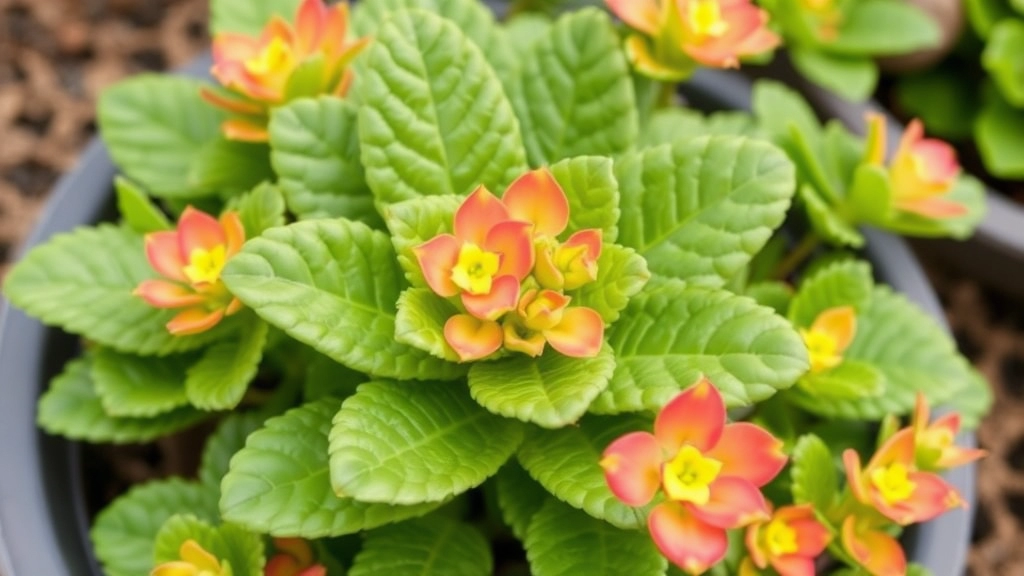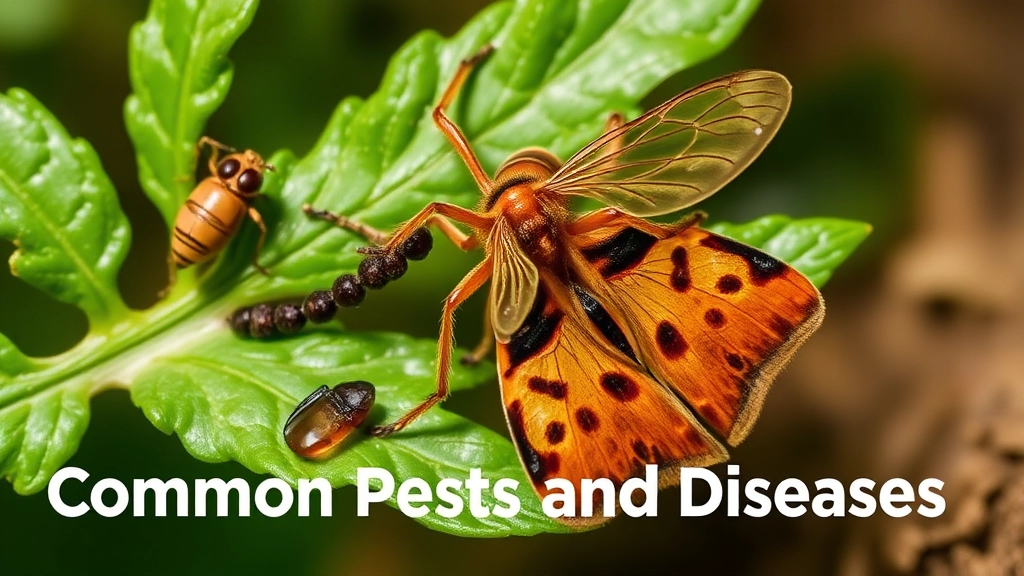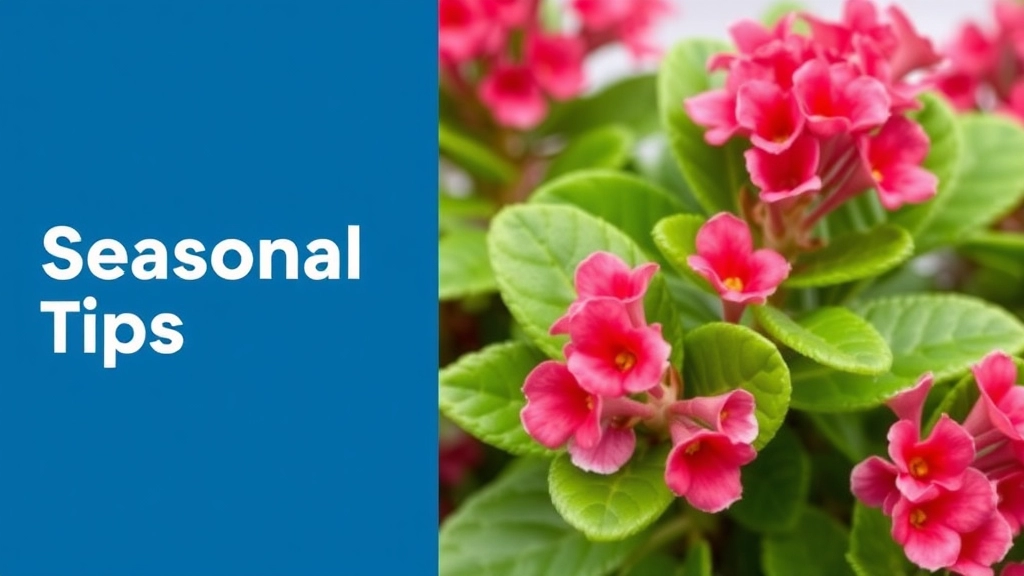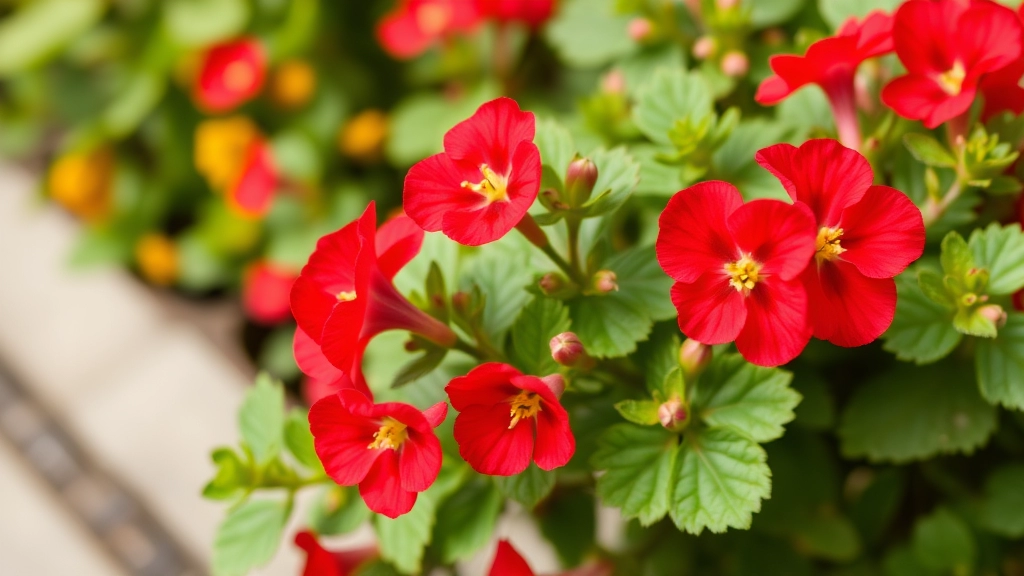Caring for Kalanchoe with Red Flowers
If you’ve ever wondered how to care for a Kalanchoe with red flowers, you’re in the right place. These vibrant succulents are not only eye-catching but also relatively easy to maintain. In this guide, I’ll share some straightforward tips to keep your Kalanchoe thriving and blooming beautifully.
Key Care Tips
- Light: Ensure your Kalanchoe gets plenty of indirect sunlight. Too much direct sunlight can scorch the leaves, while too little light can hinder its growth.
- Watering: Water your plant sparingly. Kalanchoes are drought-tolerant, so it’s better to let the soil dry out between waterings.
- Pruning: Don’t forget to prune spent blooms to encourage new growth.
Follow these simple steps, and your Kalanchoe with red flowers will be a stunning addition to your home.
Identifying Kalanchoe With Red Flowers
When exploring the vibrant world of houseplants, you may find yourself captivated by the striking beauty of Kalanchoe with red flowers.
But how do you identify this stunning succulent among the many varieties available?
Key Characteristics
- Leaves: Kalanchoe typically features thick, fleshy leaves that are green and sometimes have a slight sheen. The leaves can vary in shape, often being oval or lance-shaped.
- Flowers: The most distinguishing feature is undoubtedly its flowers. Kalanchoe blooms in clusters, and the red flowers can range from bright crimson to a deeper burgundy. They usually have a tubular shape and can be found in various sizes.
- Growth Habit: This plant tends to grow upright, reaching heights of about 30-60cm. The foliage is dense, making it visually appealing even when not in bloom.
Common Varieties
While there are numerous Kalanchoe species, the most popular ones with red flowers include:
- Kalanchoe blossfeldiana: Known for its vibrant red blooms, this variety is a common choice for indoor gardening. For more details on how to grow this plant, check out our guide on growing Kalanchoe blossfeldiana from seeds.
- Kalanchoe thyrsiflora: Although primarily known for its unique leaf shape, it can also produce red flowers. Learn more about its care in our Kalanchoe paddle plant flower care guide.
Ideal Growing Conditions for Kalanchoe

So, you’re excited about growing Kalanchoe with those stunning red flowers, but what’s the secret to keeping them thriving?
First off, let’s talk about light. Kalanchoe loves bright, indirect sunlight.
- Location: A south-facing window is perfect.
- Duration: Aim for about 6 hours of light a day.
- Avoid: Direct harsh sunlight, which can scorch those lovely leaves.
Next up, temperature. Kalanchoe prefers a warm environment.
- Ideal Range: Keep it between 20°C to 25°C (68°F to 77°F).
- Watch Out: They’re not fans of frost, so bring them indoors if it gets chilly.
Now, let’s chat about humidity.
- Preference: Kalanchoe enjoys moderate humidity.
- Tip: If your home is dry, consider misting them occasionally.
Soil is another key player in your Kalanchoe’s happiness.
- Type: Use a well-draining potting mix, like cactus or succulent soil.
- Drainage: Ensure your pot has drainage holes to prevent root rot.
Finally, let’s not forget about space.
- Pot Size: Choose a pot that’s just a bit larger than the root ball.
- Spacing: If you’re planting multiple Kalanchoes, give them some room to breathe.
Watering and Feeding Requirements
When caring for your Kalanchoe with red flowers, one of the most common concerns is how to properly water and feed this beautiful plant.
Watering Guidelines:
- Frequency: Kalanchoe prefers to dry out between waterings. Water every 2-3 weeks, allowing the top inch of soil to dry completely.
- Method: Water thoroughly until excess drains from the bottom. Avoid letting the plant sit in water, as this can lead to root rot.
- Signs of Overwatering: Yellowing leaves or a mushy stem can indicate too much water. If you notice these signs, reduce your watering frequency.
Feeding Essentials:
- Type of Fertiliser: Use a balanced, water-soluble fertiliser, ideally one formulated for succulents.
- Frequency: Feed your Kalanchoe every 4-6 weeks during the growing season (spring and summer).
- Dilution: Always dilute the fertiliser to half-strength to prevent nutrient burn.
By following these watering and feeding guidelines, you can help your Kalanchoe thrive and produce those stunning red flowers. For more detailed care instructions, check out our ultimate guide on Kalanchoe care. Additionally, if you encounter issues like yellowing leaves, our guide on Kalanchoe leaf problems can help you troubleshoot and resolve them effectively.
Common Pests and Diseases

As we delve deeper into the care of Kalanchoe, it’s essential to recognise the common pests and diseases that can affect these vibrant plants. Understanding these threats is crucial for maintaining their health and ensuring they thrive.
Common Pests
- Mealybugs:
- Small, white, cotton-like insects.
- They suck sap from the plant, causing wilting and yellowing leaves.
- Treatment: Use insecticidal soap or neem oil.
- Aphids:
- Tiny, green or black insects that cluster on new growth.
- They can distort leaves and stunt growth.
- Treatment: Spray with water to dislodge them or apply insecticidal soap.
- Spider Mites:
- Microscopic pests that thrive in dry conditions.
- Look for fine webbing and speckled leaves.
- Treatment: Increase humidity and use miticides if necessary.
Common Diseases
- Root Rot:
- Caused by overwatering and poor drainage.
- Symptoms include wilting and mushy roots.
- Prevention: Ensure pots have drainage holes and allow the soil to dry out between waterings.
- Powdery Mildew:
- White, powdery spots on leaves.
- Thrives in humid conditions.
- Treatment: Improve air circulation and apply fungicides if needed.
- Leaf Spot:
- Brown or black spots on leaves, often caused by fungal infections.
- Treatment: Remove affected leaves and avoid overhead watering.
Prevention Tips
- Regular Inspections: Check your Kalanchoe regularly for any signs of pests or disease.
- Proper Watering: Avoid overwatering to prevent root rot.
- Good Air Circulation: Ensure your plant is in a well-ventilated area to reduce humidity and prevent disease.
Pruning and Propagation Techniques
Once you’ve established a thriving Kalanchoe with red flowers, you may wonder how to keep it healthy and encourage new growth. Pruning and propagation are essential practices that can enhance the plant’s vitality and aesthetic appeal.
Pruning Your Kalanchoe
Pruning is crucial for maintaining the shape and health of your Kalanchoe. Here are some key points to consider:
- Timing: The best time to prune is after the flowering period, typically in late spring or early summer.
- Tools: Use clean, sharp scissors or pruning shears to avoid damaging the plant.
- Technique: Remove dead or wilted flowers, and trim back leggy stems to encourage bushier growth. Aim to cut just above a leaf node for optimal regrowth.
Regular pruning not only helps maintain the plant’s appearance but also promotes better air circulation and reduces the risk of disease.
Propagation Techniques
If you’re keen on expanding your Kalanchoe collection, propagation is an exciting and rewarding process. Here’s how to do it effectively:
- Leaf Cuttings:
- Select healthy leaves and cut them at the base.
- Allow the cut end to dry for a few days to form a callus.
- Place the leaf in well-draining soil and water sparingly until roots develop.
- Stem Cuttings:
- Cut a healthy stem with several leaves attached.
- Let it dry for a day or two before planting in soil.
- Water lightly and place in bright, indirect light.
- Offsets:
- Some Kalanchoe varieties produce offsets or “pups.”
- Gently remove these from the parent plant and plant them in their own pots.
By following these techniques, you can enjoy a flourishing garden filled with beautiful Kalanchoe. For detailed steps on propagating specific varieties, check out our step-by-step guide to propagating Kalanchoe Pink Butterflies. Additionally, if you’re curious about the different types of Kalanchoe and their care requirements, our comprehensive guide on Kalanchoe varieties offers valuable insights.
Seasonal Care Tips for Kalanchoe

You might be wondering how to keep your Kalanchoe thriving throughout the year.
Caring for these vibrant plants can vary with the seasons, and knowing what they need can make all the difference.
Spring
- Repotting: As the weather warms up, consider repotting your Kalanchoe if it’s outgrown its pot.
- Fertilising: Start feeding with a balanced fertiliser every few weeks to encourage growth.
- Light: Ensure they get plenty of bright, indirect sunlight.
Summer
- Watering: Increase your watering frequency, but make sure the soil dries out between waterings.
- Humidity: Kalanchoes prefer drier air, so avoid misting them.
- Pest Check: Keep an eye out for pests like mealybugs, which can be more active in warmer months.
Autumn
- Reduce Watering: As temperatures drop, scale back on watering to prevent root rot.
- Temperature: Ensure they’re kept in a warm spot, ideally above 10°C (50°F).
- Pruning: This is a great time to prune back any leggy growth to promote bushier plants.
Winter
- Light: Position your Kalanchoe in a sunny spot, as they need light to stay vibrant.
- Watering: Water less frequently; they go dormant in winter.
- Temperature: Keep them away from cold drafts and heating vents to avoid stress.
Popular Varieties of Red-Flowering Kalanchoe
As we explore the captivating world of Kalanchoe, it’s essential to understand the various popular varieties that bring vibrant red flowers to our homes and gardens.
1. Kalanchoe blossfeldiana
This classic variety is perhaps the most well-known.
- Flowering Period: Typically blooms in winter and spring.
- Growth Habit: Compact and bushy, making it ideal for pots.
- Flowers: Clusters of bright red flowers.
2. Kalanchoe ‘Calandiva’
A stunning hybrid that offers a double-flowered appearance.
- Flowering Period: Blooms throughout the year with proper care.
- Growth Habit: Slightly taller than K. blossfeldiana.
- Flowers: Rich red blooms with a fuller petal structure.
3. Kalanchoe thyrsiflora
Also known as the flapjack plant, this variety features striking red flowers.
- Flowering Period: Typically blooms in late spring to early summer.
- Growth Habit: Succulent leaves form a rosette shape.
- Flowers: Tall spikes of red tubular flowers.
4. Kalanchoe luciae
Commonly called the paddle plant, it showcases both beauty and resilience.
- Flowering Period: Flowers in late summer.
- Growth Habit: Thick, fleshy leaves that can be quite dramatic.
- Flowers: Bright red flowers that rise above the foliage.
5. Kalanchoe ‘Flapjack’
A visually striking option, perfect for those who appreciate unique shapes.
- Flowering Period: Blooms in late winter.
- Growth Habit: Flat, paddle-shaped leaves with a stunning red hue during bloom.
- Flowers: Bright red flowers that contrast beautifully with the foliage.
Choosing the right variety can enhance your indoor or outdoor space, adding a splash of colour and charm. For more detailed care tips, you might find our guide on Flaming Katy (Kalanchoe blossfeldiana) particularly useful. Additionally, if you are interested in the unique shapes of the flapjack plant, our comprehensive guide on caring for your variegated Kalanchoe flapjack succulent offers valuable insights.
FAQs about Kalanchoe with Red Flowers
What are the ideal light conditions for Kalanchoe with red flowers?
Kalanchoe thrives in bright, indirect sunlight. Aim for about 6 hours of light a day. A south-facing window is perfect, but avoid direct, harsh sunlight to prevent leaf scorching.
What temperature range is best for Kalanchoe?
Kalanchoe prefers a warm environment, ideally between 20°C to 25°C (68°F to 77°F). They are not fans of frost, so bring them indoors if it gets chilly.
How should I manage humidity for my Kalanchoe?
Kalanchoe enjoys moderate humidity. If your home is dry, consider misting the plant occasionally to maintain the desired humidity level.
What type of soil is best for Kalanchoe?
Use a well-draining potting mix, such as cactus or succulent soil. Ensure your pot has drainage holes to prevent root rot.
How do I choose the right pot size for Kalanchoe?
Select a pot that is just a bit larger than the root ball. If planting multiple Kalanchoes, provide enough space for each plant to breathe.
What are common pests that affect Kalanchoe?
Common pests include mealybugs, aphids, and spider mites. Mealybugs are small, white, and cotton-like, aphids are tiny green or black insects, and spider mites are microscopic pests that thrive in dry conditions. Use insecticidal soap or neem oil for treatment.
What diseases should I watch out for in Kalanchoe?
Common diseases include root rot, powdery mildew, and leaf spot. Root rot is caused by overwatering, powdery mildew appears as white, powdery spots on leaves, and leaf spot manifests as brown or black spots. Ensure proper watering and air circulation to prevent these diseases.
How should I care for Kalanchoe in different seasons?
Spring: Consider repotting if outgrown, start fertilizing, and ensure plenty of bright, indirect sunlight.
Summer: Increase watering frequency but let the soil dry out between waterings. Avoid misting and watch for pests.
Autumn: Reduce watering as temperatures drop, keep in a warm spot, and prune leggy growth.
Winter: Position in a sunny spot, water less frequently as they go dormant, and keep away from cold drafts and heating vents.
How can I prevent pests and diseases in Kalanchoe?
Regularly inspect your Kalanchoe for any signs of pests or disease. Avoid overwatering to prevent root rot and ensure good air circulation to reduce humidity and prevent disease. Proper care can keep your plant healthy and vibrant.
References
-
The Spruce – How to Grow Kalanchoe Plants
-
Gardening Know How – Kalanchoe Plant Care: Learn How To Grow Kalanchoe Plants
-
The Old Farmer’s Almanac – Kalanchoe
